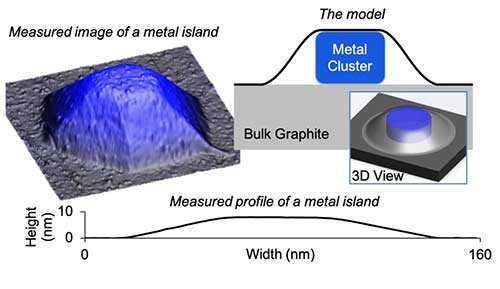A new model predicts squeezed nanocrystal shape when blanketed under graphene

In a collaboration between the U.S. Department of Energy's Ames Laboratory and Northeastern University, scientists have developed a model for predicting the shape of metal nanocrystals or "islands" sandwiched between or below two-dimensional (2-D) materials such as graphene. The advance moves 2-D quantum materials a step closer to applications in electronics.
Ames Laboratory scientist are experts in 2-D materials, and recently discovered a first-of-its-kind copper and graphite combination, produced by depositing copper on ion-bombarded graphite at high temperature and in an ultra-high vacuum environment. This produced a distribution of copper islands, embedded under an ultra-thin "blanket" consisting of a few layers of graphene.
"Because these metal islands can potentially serve as electrical contacts or heat sinks in electronic applications, their shape and how they reach that shape are important pieces of information in controlling the design and synthesis of these materials," said Pat Thiel, an Ames Laboratory scientist and Distinguished Professor of Chemistry and Materials Science and Engineering at Iowa State University.
Ames Laboratory scientists used scanning tunneling microscopy to painstakingly measure the shapes of more than a hundred nanometer-scale copper islands. This provided the experimental basis for a theoretical model developed jointly by researchers at Northeastern University's Department of Mechanical and Industrial Engineering and at Ames Laboratory. The model served to explain the data extremely well. The one exception, concerning copper islands less than 10 nm tall, will be the basis for further research.
"We love to see our physics applied, and this was a beautiful way to apply it," said Scott E. Julien, Ph.D. candidate, at Northeastern. "We were able to model the elastic response of the graphene as it drapes over the copper islands, and use it to predict the shapes of the islands."
The work showed that the top layer of graphene resists the upward pressure exerted by the growing metal island. In effect, the graphene layer squeezes downward and flattens the copper islands. Accounting for these effects as well as other key energetics leads to the unanticipated prediction of a universal, or size-independent, shape of the islands, at least for sufficiently-large islands of a given metal.
"This principle should work with other metals and other layered materials as well," said Research Assistant, Ann Lii-Rosales. "Experimentally we want to see if we can use the same recipe to synthesize metals under other types of layered materials with predictable results."
The research is further discussed in the paper "Squeezed Nanocrystals: Equilibrium Configuration of Metal Clusters Embedded Beneath the Surface of a Layered Material," published in Nanoscale.
The research was a collaboration between Ames Laboratory and Northeastern University.
More information: Scott E. Julien et al. Squeezed nanocrystals: equilibrium configuration of metal clusters embedded beneath the surface of a layered material, Nanoscale (2019). DOI: 10.1039/C8NR10549A
Journal information: Nanoscale
Provided by Ames Laboratory





















